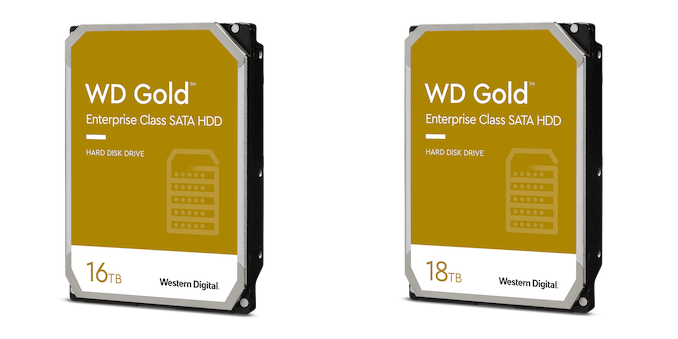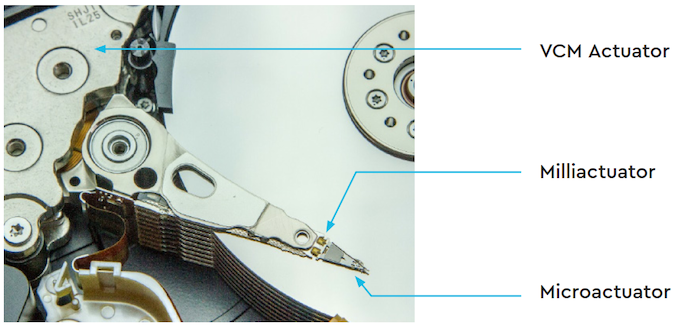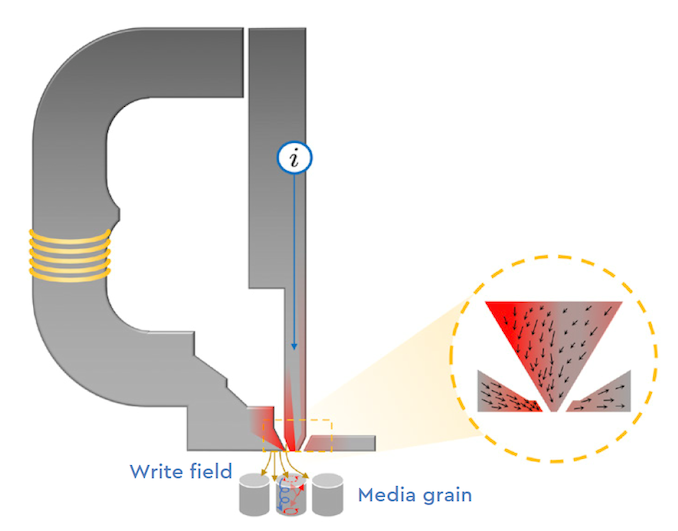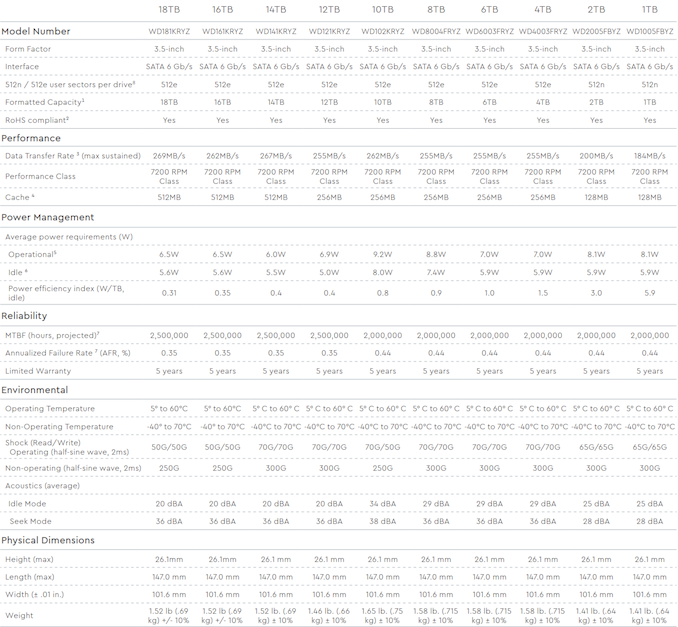Western Digital's 16TB and 18TB Gold Drives: EAMR HDDs Enter the Retail Channel
by Ganesh T S on July 9, 2020 8:00 AM EST- Posted in
- Storage
- HDDs
- NAS
- Western Digital
- MAMR
- Helium HDD
- HAMR
- CMR
- EAMR

Western Digital made a number of announcements yesterday related to their enterprise hard-disk drives (HDD) product lines. While there was nothing unexpected in terms of the products being announced, two aspects stood out - one was the retail availability of EAMR (energy-assisted magnetic recording) HDDs, and the other was additional information on the EAMR technology itself. In 2019, WD had announced the sampling of EAMR-based Ultrastar DC datacenter HDDs with 18TB and 20TB capacities. Yesterday's announcements build upon those products - the WD Gold-branded version of the Ultrastar DC CMR drives is now available for retail purchase, and the Ultrastar drives themselves have moved to general availability. The Ultrastar JBOD and storage server product lines have also been updated to utilize these new high-capacity drives.
Flash-based storage devices have taken over traditional consumer hard-drive application areas. However, increasing data storage requirements mean that HDDs still continue to be the most cost-effective solution for bulk storage. HDD vendors have been working on increasing hard drive capacities using multiple techniques. Around 10 years back, we had 2TB 3.5" HDDs with five PMR (perpendicular magnetic recording) platters in an air-filled enclosure. These drives were CMR (conventional magnetic recording) drives. In the last decade, we have seen advancements in three different categories that have enabled a 10-fold increase in the capacity of HDDs while retaining the same physical footprint:
Increasing the number of platters / making the platters thinner has been made possible by using sealed helium-filled enclosures. The reduced turbulence enables platters to be stacked closer to each other. The first-generation helium HDDs had 7 platters, and this has now grown to 9 platters for the new high-capacity drives.
The size of the writing head and the flexibility with which it can be manipulated dictate the minimum width of the recording tracks on the platters. Western Digital is claiming that they are the first to use a triple-stage actuator (TSA) in shipping HDDs.

The enhanced precision with TSA allows the TPI factor to go up. Incidentally, Seagate also has a novel actuator scheme (dual actuator), though that is aimed at increasing the throughput / IOPS.
One of the key challenges faced in the quest to increase the areal density of platters is the ability of the writing head to reliably alter the magnetic state of the grains in the tracks. Both heat-assisted magnetic recording (HAMR) and microwave-assisted magnetic recording (MAMR) are techniques that address this issue. In 2017, WD seemed set to go all-in on MAMR for their HDD product line, but three years down the road, we are looking at a variant that WD claims is a product of their HAMR and MAMR research - EAMR (energy-assisted magnetic recording).
While details were scant when EAMR was announced , WD is finally opening up on some of the technical aspects.

WD's first-generation EAMR technology (christened as ePMR) involves the application of electrical current to the writing head's main pole (this is in addition to the current sent through the voice coil) during write operations. The additional magnetic field created by this bias current ensures that the bits on the track alter their state in a more deterministic manner. In turn, this allows the bits to be packed closer together and increasing the areal density.
The above techniques can also be used with shingled magnetic recording (SMR) to boost areal density further. SMR has been around in both host-managed and drive-managed versions for a few years now. WD indicated in yesterday's announcement that qualification shipments of their 20TB Ultrastar DC host-managed SMR drive are in progress.

The WD Gold 18TB is available for purchase today and will set you back by $593. The 16TB version is priced at $528, but is currently out of stock. As is typical for enterprise drives, the two new models each have a MTBF of 2.5M hours, workload rating of 550TB/yr, and a 5 year warranty.
Source: Western Digital










69 Comments
View All Comments
Ryan Smith - Thursday, July 9, 2020 - link
Hi Brane2,With apologies, your comment is a bit nebulous, so I'm not quite sure how to parse it. Just so that I'm clear, what exactly are you saying that we got wrong/incorrect?
While we have science & engineering backgrounds, we don't live and breathe HDD technology like full-on HDD engineers do. So although we aim to get things correct, we're definitely not infallible. In this specific case, we are not aware of any issues with the technology presented by WD or their claims. But if there is something wrong, then please let us know so that we can correct it in this article and ensure it remains correct going forward.
-Thanks
Ryan Smith
sheh - Friday, July 10, 2020 - link
His comment is nebulous more than a bit. Not worth your reply time.MrVibrato - Saturday, July 11, 2020 - link
His comment is not just nebulous, it is nothing less than a Schroedingers comment. A comment that is in a superposition of saying everything and nothing at once. I mean, come on, who would be so cruel to put a comment together with a bottle of poisonous gas in a sealed dark box? Comment abuse is what it is...KAlmquist - Friday, July 10, 2020 - link
One thing I've never been able to figure out is why, now that each head has its own micro-actuator, no one has made a hard drive that can read or write more than one platter at the same time. That wouldn't do much of anything to improve performance for random reads and writes, but would allow sequential I/O operations to be much faster. For example, if a single head can only read 150 MB/sec, but you have 6 heads, sequential read performance should be 900 MB/sec. If a 16TB disk in a RAID array had to be replaced, the replacement disk could be filled with data in less than half an hour. (OK, more if you are limited by the bandwidth to the host, but still, you get the point. Sequential performance matters for RAID array rebuilds even if your workload is purely random.)Maybe the drive manufacturers have been using essentially the same controller technology for years and it would cost too much to come up with a new design that could access multiple heads at once?
sheh - Friday, July 10, 2020 - link
Maybe you need a larger movement range.Or maybe it's being worked on and would finally materialize in a few years. One can hope.
DanNeely - Friday, July 10, 2020 - link
Could be that two heads on the same arm trying to write at once would interfere with each other.extide - Friday, July 10, 2020 - link
That is how they work. On a 9 platter drive all 18 heads are reading/writing at the same time, the data is essentially striped across them.Kvaern1 - Saturday, July 11, 2020 - link
This, and it's noticeably the reason why larger HDs are faster than smaller ones from the same series.sheh - Sunday, July 12, 2020 - link
There are mainly (or only?) two things that increase linear speed: RPM, and linear data density.Not directly related, but here's an interesting study on HDD geometry:
http://blog.stuffedcow.net/2019/09/hard-disk-geome...
sheh - Sunday, July 12, 2020 - link
That's not how they work. If it were, A 9 platter drive would be 9 times faster than a 1 platter drive.